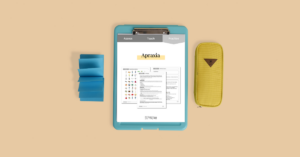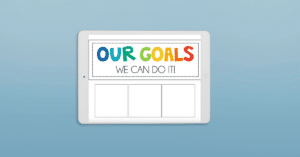This is a guest post from Rachel, SLP Now’s Community Manager, sharing tips on how to write goals for stuttering & fluency!
Are you a speech-language pathologist wondering how to write stuttering and fluency goals? Good news, you’ve come to the right place! This is an SLP’s guide to writing effective fluency goals.
What is Stuttering?
According to the National Stuttering Association (NSA), stuttering is “a difference in speech pattern involving disruptions, or ‘disfluencies’ in a person’s speech.” The NSA states the term “stuttering” can refer to the disfluencies produced in the speech of someone who stutters, or it can refer to the overall difficulty with communication someone may experience due to stuttering.
What are the Different Types of Stuttering?
Stuttering is unique to each person who stutters, and their speech is not limited to just one type of disfluency. As ASHA states, types of stuttering includes repetitions, prolongations, and blocks/stops.
Repetitions – part-word repetitions and one-syllable word repetitions – “m-m-my” “my-my-my dog”
Prolongations – the holding out of a sound – “mmmmy dog”
Blocks or stops – a pause in the middle of a word or sentence – “m_______y dog” “my (pause) dog”
How to Write Effective Fluency Goals for Your Speech Therapy Students
If you were the evaluating speech language pathologist… Great news! During your evaluation, you spent a lot of time gathering your student’s case history, informally and formally assessing their fluency and feelings about their stuttering, as well as observing your student across various settings. Use the information you’ve already collected to drive your goal writing!
If you weren’t the speech language pathologist who evaluated the student, these 3 factors to writing effective speech fluency goals will be super helpful when it comes to knowing how to write fluency goals that best help your speech therapy students.
Get a Thorough Case History
Understanding a speech student’s case history is a huge part of understanding the whole student. Gaining background on the student’s family history, how long a student has been stuttering, home environment, and previous medical history is very important.
Observe the Student in Multiple Environments
A student’s fluency can change depending on their environment. It is crucial to observe them in different environments to ensure you’re writing goals that will benefit the student.
Establish Rapport
When you have a rapport built with a student, they will be more comfortable sharing their feelings and attitudes about their stutter, which will help guide your goal writing.
3 Areas of Communication to Focus on When Writing Goals for Fluency Therapy
Now that we have gathered a thorough case history, observed our student in multiple settings, and have built rapport, it is time to write some fluency goals! When writing fluency goals for your speech therapy students, there are 3 areas of communication you should keep in mind: counseling, education, and stuttering modification.
1. Counseling
As speech-language pathologists, it is huge that we understand the attitude and emotions our students have toward their stuttering. Counseling goals may be social, such as initiating conversation with peers or creating a hierarchy of least to most stressful speaking situations.
2. Education
When targeting goals on stuttering education, we are teaching students about how their speech mechanism works, what stuttering is, different types of stuttering, etc. Knowledge is power, and we want our speech students to understand stuttering!
3. Stuttering Modification
This is where we introduce speech fluency and modification strategies into our goals!
7 Speech Fluency Techniques and Stuttering Modification Strategies for Speech Language Pathologists
There is no one-size-fits-all fluency strategy, so it is important to see which fluency techniques your speech student prefers and which fluency techniques helps their fluency the most.
While these 7 speech fluency techniques are not the only speech fluency techniques out there, they are techniques we have seen be super helpful for our students. Stephen Groner (aka SLP Stephen) does an amazing job describing each of these techniques (and more!) with amazing detail in his blog post on stuttering treatment techniques.
1. Syllable-Timed Speech Technique
The syllable-time speech technique involves having the student break each word into syllables while speaking.
2. Cancellation Technique
The cancellation technique involves having the student pause after they’ve started stuttering, repeating it again without tension, and stretching out the stuttered sound.
3. Pull-Out Technique
For the pull-out technique, while the student is stuttering, the student will stretch out the stuttered sound gently.
4. Light Bounces Technique
The light bounce technique is a strategy to use while the student stutters. Have the student stutter, however instead of there being a lot of tension, the student will continue through the stutter without as much tension by using light contact.
5. Voluntary Stuttering Technique
Intentionally adding stuttering to your student’s speech during the voluntary stuttering technique allows the person who stutters to gain control of their speech.
6. Reduced Rate Technique
This technique encourages your student to slow down the rate of their speech.
7. Pauses and Phrasing Technique
The pause and phrase technique has your student add more pauses into their speech.
Fluency Goal Bank for Speech-Language Pathologists
I know how overwhelming writing fluency goals can be. When writing goals for stuttering, it is important to think of your goals from the social model of disability. We don’t want to change our students, we want to support our students and change the environment to set them up for success.
You can use the SLP Now Speech Therapy Goal Bank for some inspiration on speech fluency targets. Remember to personalize goals to your student’s specific strengths and needs!
5 Examples of Fluency and Stuttering Goals For Speech-Language Pathologists
Goal 1: Student will demonstrate knowledge of different types of stuttering (e.g., repetition, prolongation, blocks), by producing the definitions to the speech therapist (verbally, written) in 3/3 opportunities.
Goal 2: Student will describe fluency techniques (e.g. easy start, light contact). by describing each technique to the therapist (verbally, written) in 4/5 opportunities.
Goal 3: Student will decrease their stuttering instances by implementing the use of fluency techniques (e.g., easy start, light contact) from [baseline percentage/#of instances] to [mastery percentage/#of instances].
Goal 4: Student will implement self-chosen fluency-enhancing technique in #/10 of opportunities, given no more than 1 visual cue.
Goal 5: Student will self-disclose stuttering to individuals chosen by the student (e.g. teachers and/or friends), using a method preferred by the student, in 4/5 opportunities.
Parent & Teacher Stuttering Resources
Like any goal we target in speech therapy, we do not want the student to make progress in the speech therapy room, only to lose it when they leave. This is why educating and providing our students’ teachers and parents with resources is huge for our speech student’s progress.
For a list of stuttering resources to provide to parents and teachers (or anyone else for that matter!), this blog post provides a comprehensive list of stuttering resources that do an amazing job of clearly describing stuttering as well as explaining stuttering from the perspective of people who stutter!
References
National Stuttering Association. (n.d.) What is Stuttering? Understanding Stuttering. https://westutter.org/understanding-stuttering/




Hi, Marisha!
My name is Ashley. I am a school-based SLP in Manhattan. I just wanted to write to you and say thank you for creating and sharing this resource with other professionals. It is extremely helpful and appreciated.